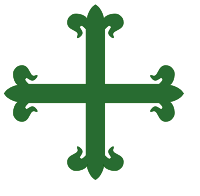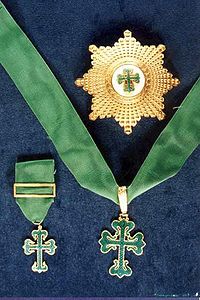Order of Aviz
| Order of Aviz (Ordem Militar de Avis) |
|
|---|---|

Emblem of the Order
|
|
| Awarded by Award of |
|
| Type | Honorific Order |
| Religious affiliation | Roman Catholic |
| Ribbon | Green |
| Eligibility | Portuguese and foreign military personnel |
| Awarded for | Outstanding military merit |
| Status | Currently awarded |
| Grand Master | President of Portugal |
| Statistics | |
| Established | 1146 (founded) 1789 (secularized) |
| Precedence | |
| Next (higher) | Order of Christ |
| Next (lower) | Order of Saint James of the Sword |
 Decorations of the Order |
|
The Military Order of Aviz (Portuguese: Ordem Militar de Avis, pronounced: [ɐˈviʃ]), previously to 1910 Royal Military Order of Aviz (Portuguese: Ordem Real Militar de Avis), previously to 1789 Order of Saint Benedict of Aviz (Portuguese: Ordem de São Bento de Aviz), previously Knights of St. Benedict of Aviz or Friars of Santa Maria of Évora, is a Portuguese Order of Chivalry. It gave its name and coat of arms to the Aviz Dynasty that ruled Portugal between 1385 and 1580.
The order, as a monastic military order, was founded in emulation of such military orders as the Knights Templar, which existed in Portugal as early as 1128, and received a grant from Theresa, Countess of Portugal in the year of the Council of Troyes, which confirmed their early statutes. A native order of this kind sprang up in Portugal about 1146. Afonso, the first King gave to it the town of Évora, captured from the Moors in 1166, and the Knights were first called "Friars of Santa Maria of Évora". Pedro Henriques, an illegitimate son of the King's father, was the first grand master.
After the conquest of Aviz a castle erected there became the motherhouse of the order, and they were then called "Knights of St. Benedict of Aviz", since they adopted the Benedictine rule in 1162, as modified by John Ziritu, one of the earliest Cistercian abbots of Portugal. Like the Knights of Calatrava in Castile, the Knights of Portugal were indebted to the Cistercians for their rule and their habit—a white mantle with a green fleur-de-lysed cross. The Knights of Calatrava also surrendered some of their places in Portugal to them on condition that the Knights of Aviz should be subject to the visitation of their grand master. Hence the Knights of Aviz were sometimes regarded as a branch of the Calatravan Order, although they never ceased to have a Portuguese grand master, dependent for temporalities on the Portuguese King.
...
Wikipedia
